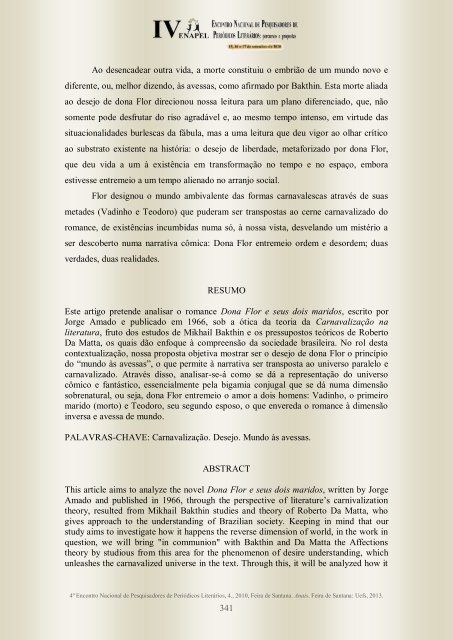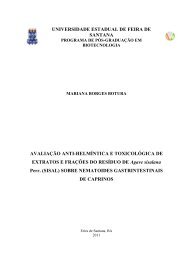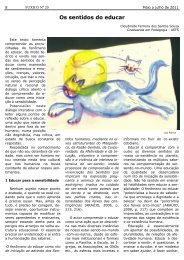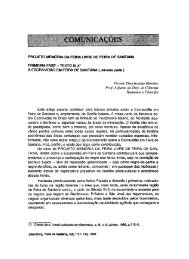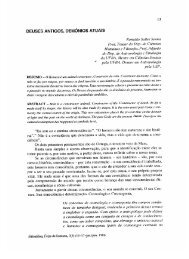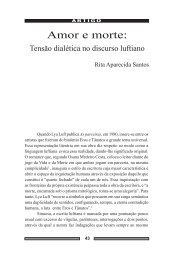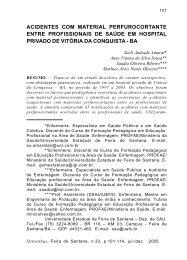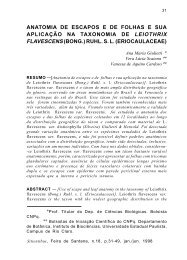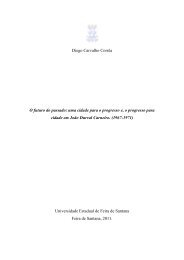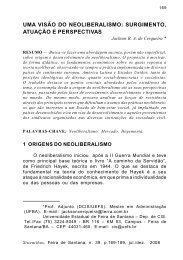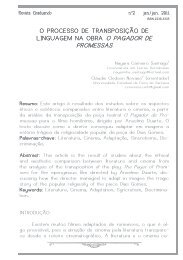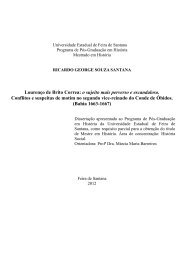o desejo como princípio do avesso - Universidade Estadual de Feira ...
o desejo como princípio do avesso - Universidade Estadual de Feira ...
o desejo como princípio do avesso - Universidade Estadual de Feira ...
You also want an ePaper? Increase the reach of your titles
YUMPU automatically turns print PDFs into web optimized ePapers that Google loves.
Ao <strong>de</strong>senca<strong>de</strong>ar outra vida, a morte constituiu o embrião <strong>de</strong> um mun<strong>do</strong> novo e<br />
diferente, ou, melhor dizen<strong>do</strong>, às avessas, <strong>como</strong> afirma<strong>do</strong> por Bakthin. Esta morte aliada<br />
ao <strong><strong>de</strong>sejo</strong> <strong>de</strong> <strong>do</strong>na Flor direcionou nossa leitura para um plano diferencia<strong>do</strong>, que, não<br />
somente po<strong>de</strong> <strong>de</strong>sfrutar <strong>do</strong> riso agradável e, ao mesmo tempo intenso, em virtu<strong>de</strong> das<br />
situacionalida<strong>de</strong>s burlescas da fábula, mas a uma leitura que <strong>de</strong>u vigor ao olhar crítico<br />
ao substrato existente na história: o <strong><strong>de</strong>sejo</strong> <strong>de</strong> liberda<strong>de</strong>, metaforiza<strong>do</strong> por <strong>do</strong>na Flor,<br />
que <strong>de</strong>u vida a um à existência em transformação no tempo e no espaço, embora<br />
estivesse entremeio a um tempo aliena<strong>do</strong> no arranjo social.<br />
Flor <strong>de</strong>signou o mun<strong>do</strong> ambivalente das formas carnavalescas através <strong>de</strong> suas<br />
meta<strong>de</strong>s (Vadinho e Teo<strong>do</strong>ro) que pu<strong>de</strong>ram ser transpostas ao cerne carnavaliza<strong>do</strong> <strong>do</strong><br />
romance, <strong>de</strong> existências incumbidas numa só, à nossa vista, <strong>de</strong>svelan<strong>do</strong> um mistério a<br />
ser <strong>de</strong>scoberto numa narrativa cômica: Dona Flor entremeio or<strong>de</strong>m e <strong>de</strong>sor<strong>de</strong>m; duas<br />
verda<strong>de</strong>s, duas realida<strong>de</strong>s.<br />
RESUMO<br />
Este artigo preten<strong>de</strong> analisar o romance Dona Flor e seus <strong>do</strong>is mari<strong>do</strong>s, escrito por<br />
Jorge Ama<strong>do</strong> e publica<strong>do</strong> em 1966, sob a ótica da teoria da Carnavalização na<br />
literatura, fruto <strong>do</strong>s estu<strong>do</strong>s <strong>de</strong> Mikhail Bakthin e os pressupostos teóricos <strong>de</strong> Roberto<br />
Da Matta, os quais dão enfoque à compreensão da socieda<strong>de</strong> brasileira. No rol <strong>de</strong>sta<br />
contextualização, nossa proposta objetiva mostrar ser o <strong><strong>de</strong>sejo</strong> <strong>de</strong> <strong>do</strong>na Flor o <strong>princípio</strong><br />
<strong>do</strong> “mun<strong>do</strong> às avessas”, o que permite à narrativa ser transposta ao universo paralelo e<br />
carnavaliza<strong>do</strong>. Através disso, analisar-se-á <strong>como</strong> se dá a representação <strong>do</strong> universo<br />
cômico e fantástico, essencialmente pela bigamia conjugal que se dá numa dimensão<br />
sobrenatural, ou seja, <strong>do</strong>na Flor entremeio o amor a <strong>do</strong>is homens: Vadinho, o primeiro<br />
mari<strong>do</strong> (morto) e Teo<strong>do</strong>ro, seu segun<strong>do</strong> esposo, o que envereda o romance à dimensão<br />
inversa e avessa <strong>de</strong> mun<strong>do</strong>.<br />
PALAVRAS-CHAVE: Carnavalização. Desejo. Mun<strong>do</strong> às avessas.<br />
ABSTRACT<br />
This article aims to analyze the novel Dona Flor e seus <strong>do</strong>is mari<strong>do</strong>s, written by Jorge<br />
Ama<strong>do</strong> and published in 1966, through the perspective of literature’s carnivalization<br />
theory, resulted from Mikhail Bakthin studies and theory of Roberto Da Matta, who<br />
gives approach to the un<strong>de</strong>rstanding of Brazilian society. Keeping in mind that our<br />
study aims to investigate how it happens the reverse dimension of world, in the work in<br />
question, we will bring "in communion" with Bakthin and Da Matta the Affections<br />
theory by studious from this area for the phenomenon of <strong>de</strong>sire un<strong>de</strong>rstanding, which<br />
unleashes the carnavalized universe in the text. Through this, it will be analyzed how it<br />
4º Encontro Nacional <strong>de</strong> Pesquisa<strong>do</strong>res <strong>de</strong> Periódicos Literários, 4., 2010, <strong>Feira</strong> <strong>de</strong> Santana. Anais. <strong>Feira</strong> <strong>de</strong> Santana: Uefs, 2013.<br />
341


